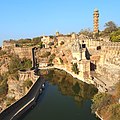Vijaya Stambha
| Vijaya Stambha | |
|---|---|
| General information | |
| Type | Tower |
| Location | Chittorgarh, Rajasthan, India |
| Coordinates | 24°53′16″N 74°38′43″E / 24.887870°N 74.645157°E |
| Completed | 1448[1] |
| Height | 37.19 m (122 ft)[1] |
| Technical details | |
| Floor count | 9[1] |
| Design and construction | |
| Architect(s) | Sutradhar Jaita[1] |
The Vijaya Stambha is an imposing victory monument located within Chittorgarh fort in Chittorgarh, Rajasthan, India. The tower was constructed by the Mewar king, Rana Kumbha, in 1448 to commemorate his victory over the combined armies of Malwa and Gujarat led by Mahmud Khilji. The tower is dedicated to Vishnu.[1]
While Vijaya Stambha is its common name, it is technically a Kirttistambha or Kirti Stambha, a "tower of fame".[1][2]
Inscriptions
The inscribed slabs in the uppermost story containing a detailed genealogy of the rulers of Chittaur and their deeds is ascribed to Ran Kumbha court scholar, Atri and his son Mahesh. The names of the architect, Sutradhar Jaita and his three sons who assisted him, Napa, Puja, and Poma, are carved on the eighteen floor of the tower.[1]
The Vijaya Stambha is a remarkable example of religious pluralism practised by the Rajputs. The topmost storey features an image of the Jain Goddess, Padmavati. Rana Kumbha also had the word Allah carved in Arabic nine times in the third storey and eight times in the eighth.[3][4]
Gallery
-
Guidestone
-
A photograph of the tower c. 1875.[5]
-
A view of the tower from 1924 by Georg Morgenstierne
-
Vijaya Stambha with Gaumukh reservoir in the foreground.
See also
References
- ^ a b c d e f g "Chittaurgarh Fort, Distt. Chittaurgarh". Archaeological Survey of India. Retrieved 15 April 2015.
- ^ Chandra, Satish (2004). Medieval India: From Sultanat to the Mughals-Delhi Sultanat (1206-1526) - Part One. Har-Anand Publications. p. 224. ISBN 9788124110645.
- ^ Chittorgarh, Shobhalal Shastri, 1928, pp. 64-65
- ^ Ali, M. Athar (January 1990). "Encounter and Efflorescence: Genesis of the Medieval Civilization". Social Scientist. 18 (1/2): 20. JSTOR 3517324.
{{cite journal}}: Unknown parameter|subscription=ignored (|url-access=suggested) (help) - ^ "Tower of victory [or Jaya Stambh], Chitor". www.bl.uk. British Library. Retrieved 4 August 2017.
External links
 Media related to Vijaya Stambha at Wikimedia Commons
Media related to Vijaya Stambha at Wikimedia Commons





![A photograph of the tower c. 1875.[5]](http://upload.wikimedia.org/wikipedia/commons/thumb/7/71/Vijaya_Stambha_in_1870s.jpg/97px-Vijaya_Stambha_in_1870s.jpg)

